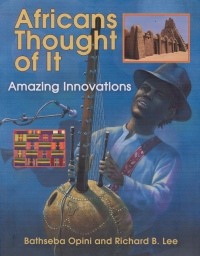| ________________
CM . . . . Volume XVII Number 35. . . .May 13, 2011. 
 |
Africans Thought of It: Amazing Innovations. (We Thought of It.).
Bathseba Opini & Richard B. Lee.
Toronto, ON: Annick Press, 2011.
48 pp., pbk. & hc., $11.95 (pbk.), $21.95 (hc.).
ISBN 978-1-55451-276-8 (pbk.), ISBN 978-1-55451-277-5 (hc.).
Subject Headings:
Africa-Civilization-Juvenile literature.
Africa-Intellectual life-Juvenile literature.
Inventions-Africa-Juvenile literature.
Grades 4-6 / Ages 9-11.
Review by Sherry Faller.
****/4
|
| |
|

excerpt:
The development of the plow allowed farmers to work land much more efficiently than using a hoe, such as the hilaire. One traditional African plow used in Ethiopia was called a maresha. It had a metal point connected to a wooden arm. On each side of the metal point there were pieces of wood that pushed the soil aside. A long pole connected the plowing tool to a yoke, which allowed two oxen to pull the plow. The farmer held on to the wooden arm while plowing. He could adjust the angle of the arm to control how deeply the metal point cut into the soil.
This fascinating, informative book is the fourth in the series, preceded by The Inuit Thought of It, A Native American Thought of It, and The Chinese Thought of It. Continuing in the same format as the others, Africans Thought of It illustrates how many of the things we use every day had their roots somewhere in Africa. Intended for middle years students, this book is a wealth of information for anyone studying about African countries and their cultures.
Africans Thought of It begins with a table of contents and ends with a timeline, further reading suggestions, an index and information about the authors. Of course, there is an up-to-date political map as well as a topographical one. Throughout the whole book, the page background is a warm yellow-orange, like the grasses of the savannah. Starting at the beginning when people survived by hunting and gathering, the weapons are illustrated as well as how the people added deadly poison to the arrow tips. Continuing with the development of man’s innovations, agriculture, architecture, working with metals, and medicine are explained. The section on arts and crafts and hairstyles will be of particular interest. Other topics are communication, food, musical instruments, and games and sports. Africa today is the final segment which demonstrates to the reader that many Africans live as we do; yes, they even have computers!
The illustrations are colourful photographs of the people, landscape, architecture and animals. There are only a few drawings that demonstrate the process of some of the innovations. All photos are captioned making this an easier read for students struggling with reading large passages. Abundant research has gone into the creation of this book. The framed boxes with deeper information vary in style from bulleted facts to multiple paragraphs, thereby reaching readers of many levels.
The authors have made Africa less like a “country,” but more a collection of many countries, with innovations, customs and lifestyle entirely their own. Students and adults alike will enjoy reading about the sources of things we have learned to take for granted and possibly regard as North American grown. I would highly recommend this book for all school libraries.
Highly Recommended.
Sherry Faller is a teacher-librarian in Winnipeg, MB.

To comment on this title or this review, send mail to
cm@umanitoba.ca.
Copyright © the Manitoba Library Association. Reproduction for personal use is permitted only if this copyright notice is maintained. Any other reproduction is prohibited without permission.
NEXT REVIEW |
TABLE OF CONTENTS FOR THIS ISSUE- May 13, 2011.
AUTHORS |
TITLES |
MEDIA REVIEWS |
PROFILES |
BACK ISSUES |
SEARCH |
CMARCHIVE |
HOME |
